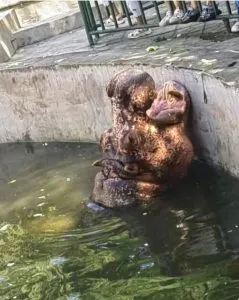A Morning Surprise Turned Near-Disaster
It was a quiet morning like any other. I walked into the yard, glanced toward the grass, and saw something that looked like a child's toy lying among the fallen leaves. Curious, I took a few steps closer—thankfully not too close. Something didn’t feel right.
Then I realized it wasn’t a toy at all.

It was a Gaboon viper—one of the most venomous and dangerous snakes on Earth. The shock still sends chills down my spine. Had I tried to pick it up or lingered for just a few seconds more, I might not be here to tell this story.
What Is a Gaboon Viper?
The Gaboon viper (Bitis gabonica) is native to the rainforests and savannas of sub-Saharan Africa. It’s not just deadly—it’s a master of disguise. With its earth-toned patterns, it blends seamlessly into leaf litter and underbrush. This natural camouflage makes it nearly invisible, even in plain sight.

Here are some jaw-dropping facts about this formidable snake:
-
Size: Can reach up to 2 meters (6.5 feet) in length
-
Weight: Up to 8 kilograms (17 pounds), making it the heaviest venomous snake in the world
-
Fangs: Measures an astonishing 5 centimeters (2 inches) — the longest fangs of any snake species
-
Venom: Highly potent; capable of causing massive tissue destruction and life-threatening blood clotting
-
Diet: Preys on birds, rodents, and even large animals like hedgehogs and small antelopes
-
Behavior: Usually calm and sedentary, but if disturbed, it strikes with lightning speed and lethal precision
Despite its power, the Gaboon viper is not considered aggressive toward humans. Most encounters happen by accident, like mine. People often step on them without realizing it—because these snakes stay perfectly still.
The Real Danger: Camouflage and Complacency

What makes the Gaboon viper so dangerous isn’t just its venom, but its perfect camouflage. It can lie motionless for hours, completely hidden in leaves and grass. For homeowners or hikers in regions where this species is found, this poses a very real threat.
Imagine walking barefoot in your garden or letting your kids play nearby—never suspecting that a deadly creature is just inches away.
It’s important to remember:
-
Always be alert when walking through leaf-covered areas or dense vegetation
-
Wear shoes with thick soles if you live in snake-prone regions
-
Teach children to avoid picking up unknown objects outdoors
-
Call wildlife control immediately if you suspect the presence of a venomous snake
What to Do If Bitten by a Gaboon Viper

If a bite occurs, every second counts. The venom of the Gaboon viper can lead to shock, necrosis, and internal bleeding. Without prompt antivenom treatment, survival becomes extremely unlikely.
Here’s what you should do:
-
Stay calm and limit movement — venom spreads faster with increased heart rate
-
Call emergency services immediately
-
Do not try to suck the venom or use a tourniquet
-
Keep the bite area below heart level
-
Avoid any home remedies — only trained medical professionals and antivenom can help
Final Thoughts: A Deadly Reminder to Stay Vigilant
That morning taught me a lesson I’ll never forget. I was lucky — incredibly lucky. The Gaboon viper could have taken my life in a matter of minutes, and I wouldn’t have even known what hit me.
These snakes are a reminder of nature’s hidden dangers, especially in areas where wildlife and human environments overlap. Whether you're working in the yard, hiking through the forest, or even relaxing at home, always keep an eye out. Not everything that looks like a toy… is harmless.

-1750412566-q80.webp)

